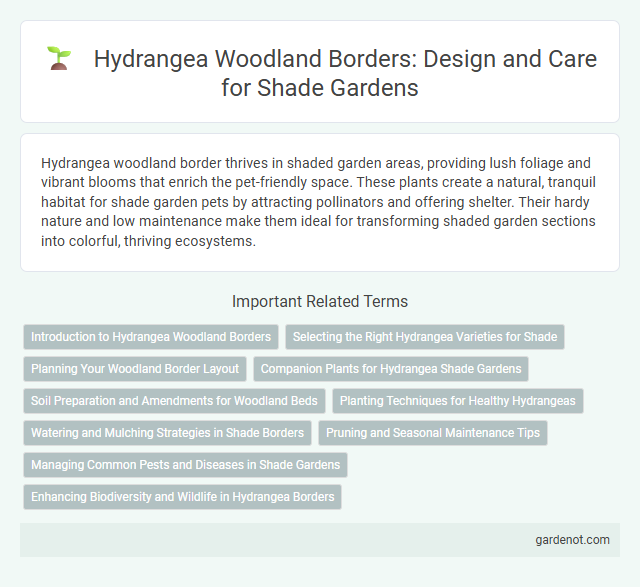Hydrangea woodland border thrives in shaded garden areas, providing lush foliage and vibrant blooms that enrich the pet-friendly space. These plants create a natural, tranquil habitat for shade garden pets by attracting pollinators and offering shelter. Their hardy nature and low maintenance make them ideal for transforming shaded garden sections into colorful, thriving ecosystems.
Introduction to Hydrangea Woodland Borders
Hydrangea woodland borders create a lush, shaded garden retreat with their large, vibrant flower clusters and broad green foliage. These shade-loving plants thrive in well-drained, moist soil enriched with organic matter, making them ideal for woodland settings. Incorporating hydrangeas into border planting enhances seasonal interest with blooms that range from white to pink and blue, attracting pollinators and complementing shade-tolerant understory plants.
Selecting the Right Hydrangea Varieties for Shade
Selecting the right hydrangea varieties for a woodland shade garden enhances both beauty and growth success, with Hydrangea arborescens and Hydrangea macrophylla being top choices. These varieties thrive in partial to full shade, offering lush foliage and vibrant blooms that complement the dappled light of woodland borders. Prioritize cultivars like 'Annabelle' for white flowers and 'Nikko Blue' for blue blooms to create a dynamic, shade-friendly garden display.
Planning Your Woodland Border Layout
Hydrangea woodland border planning involves selecting shade-tolerant species that thrive in acidic, well-drained soil with consistent moisture. Arrange taller hydrangea varieties like Hydrangea arborescens at the back, with smaller groundcover plants in front to create layered foliage and seasonal blooms. Incorporate native ferns and hostas to enhance texture and ensure year-round interest in your shaded garden border.
Companion Plants for Hydrangea Shade Gardens
Hydrangea woodland borders thrive when paired with companion plants such as ferns, hostas, and astilbes that share similar shade and moisture preferences. These shade-tolerant plants enhance the lush, layered texture of the garden while providing contrasting leaf shapes and colors that complement hydrangea blooms. Incorporating spring bulbs like trilliums or bleeding hearts can also add seasonal interest and biodiversity to hydrangea shade gardens.
Soil Preparation and Amendments for Woodland Beds
Hydrangea woodland borders thrive in well-drained, acidic soils rich in organic matter, making soil preparation crucial for healthy growth. Incorporate ample leaf mold, composted pine needles, and well-aged manure to improve soil texture and nutrient content while maintaining the preferred pH range of 5.5 to 6.5. Regular mulching with organic materials helps retain moisture, suppress weeds, and supports the symbiotic fungi essential for hydrangeas in woodland beds.
Planting Techniques for Healthy Hydrangeas
Hydrangea woodland border planting techniques emphasize well-drained, humus-rich soil with consistent moisture to promote healthy growth. Position hydrangeas in areas with dappled shade to mimic their natural woodland habitat, reducing stress and enhancing vibrant blooms. Mulching with organic materials preserves soil moisture and regulates temperature, crucial for maintaining plant vigor in shaded garden settings.
Watering and Mulching Strategies in Shade Borders
Hydrangea woodland borders thrive with consistent watering to maintain moist, well-drained soil, especially during dry spells. Applying 2-3 inches of organic mulch such as shredded bark or leaf mold conserves moisture, suppresses weeds, and regulates soil temperature in shade gardens. Regular monitoring of soil moisture combined with mulch renewal ensures optimal hydration and healthy root development for Hydrangeas in shaded environments.
Pruning and Seasonal Maintenance Tips
Hydrangea woodland border plants require precise pruning to encourage healthy growth and vibrant blooms, typically performed after flowering in late summer or early fall. Remove dead or weak stems to improve air circulation and shape the plant, preventing disease in shaded garden areas. Seasonal maintenance includes mulching to retain moisture and applying balanced fertilizer in early spring to support robust development amidst woodland conditions.
Managing Common Pests and Diseases in Shade Gardens
Hydrangea woodland borders thrive in shade gardens but require vigilant management of common pests like aphids, spider mites, and scale insects that can damage foliage and flowers. Regular inspection and use of insecticidal soaps or neem oil help control infestations, while ensuring proper air circulation reduces risks of fungal diseases such as powdery mildew and leaf spot. Maintaining healthy soil with balanced moisture and organic mulch supports plant resilience against pests and disease, promoting vibrant growth in shaded environments.
Enhancing Biodiversity and Wildlife in Hydrangea Borders
Hydrangea woodland borders create a thriving habitat that supports diverse wildlife by providing shelter and food sources such as nectar-rich flowers for pollinators and seeds for birds. These borders encourage the presence of beneficial insects, including bees and butterflies, which enhance pollination and contribute to a balanced ecosystem. Incorporating native plant species alongside Hydrangeas further promotes biodiversity by attracting a wider range of wildlife and fostering ecological resilience.
Hydrangea woodland border Infographic

 gardenot.com
gardenot.com